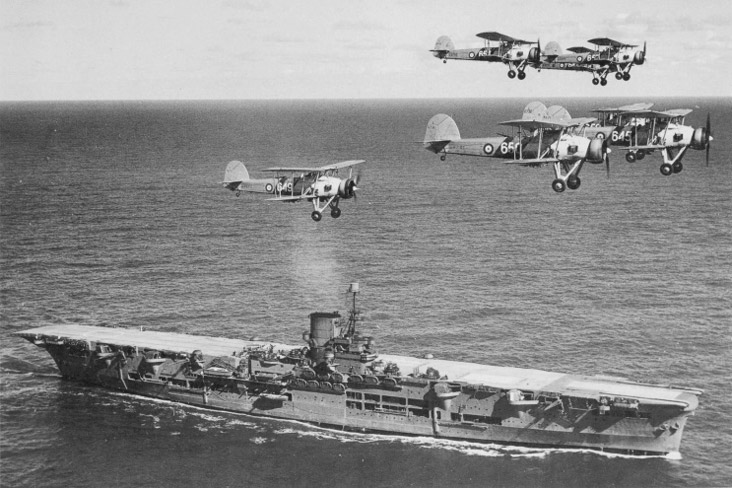Battleships Beat the Bombers
The War Illustrated, Volume 1, No. 5, Page 143, October 14, 1939.
The first surface naval engagement of the war was a raid by Nazi warplanes on a section of Britain's Navy, on patrol in the North Sea. The Germans claimed it as a famous victory until Mr. Churchill effectively pricked the bubble of their lie.
Shortly before war broke out the Home Fleet sailed literally into the blue, and for nearly a month not a word was heard of its activities. From time to time there were reports of heavy gunfire heard in the North Sea, but the first real news of an engagement in which the capital ships of the British Navy were involved was contained in a message to the Admiralty from Sir Charles Forbes, Commander-in-Chief of the Home Fleet.
Giving the news to the House of Commons on the afternoon of September 28, Mr. Winston Churchill, First Lord of the Admiralty, read the radio message from Sir Charles, as follows:
"Yesterday afternoon, in the middle of the North Sea, a squadron of British capital ships, an aircraft carrier, cruisers and destroyers were attacked by about 20 German aircraft.
"No British ship was hit and no British casualties were incurred.
"A German flying-boat was shot down and another badly damaged."
On the same day the German wireless issued their account of the action. "German air forces", it ran, "successfully attacked British naval forces, battleships, aircraft carriers, cruisers and destroyers in the central North Sea yesterday. Apart from an aircraft carrier, which was destroyed, several heavy hits were made on a battleship. Our aeroplanes did not suffer any losses."
Following the statement, Mr. A. V. Alexander expressed the "hope that the public who listen in to English broadcasts from Germany will take this as an example of the veracity of their statements".
When the laughter at this thrust at Nazi propaganda had subsided, Mr. Churchill got on to his feet again. "I agree", he said, "and I might have added that another German aircraft came down and we sent out a destroyer to collect her. Her crew of four have been brought in as prisoners." This further verification of the accuracy of the British report was received with loud cheers. Once again, a Nazi statement had been shown to be – well, a "terminological inexactitude", to recall Mr. Churchill's famous phrase of years ago.
Further details of the engagement were made available later. It seems that a British submarine which had been damaged in an action with German forces was returning to its base, covered by a naval squadron, when the German machines delivered their assault. A certain amount of cloud at about 12,000 feet had screened their approach, and they made their attack through a break in the cloud with throttles full open. Such a power dive attack is perhaps the most dangerous to which a big ship may be exposed, and it reflects great credit on the anti-aircraft defences of the fleet that the 'planes were beaten off with such heavy loss. Here was a target of some 17 ships – and not a single one was hit!
 When, in the action described in this page, a number of German aircraft delivered an attack on a British squadron off the coast of Norway, among the results claimed, without a shadow of justification, was the destruction of an aircraft carrier. In this photograph we see one of the Navy's complement of aircraft carriers – the 22,000-ton H.M.S. Ark Royal, mentioned in the German claims. Flying above her are some of her complement of aeroplanes. They have just taken off from the huge flight deck. Photo, Charles Brown.
When, in the action described in this page, a number of German aircraft delivered an attack on a British squadron off the coast of Norway, among the results claimed, without a shadow of justification, was the destruction of an aircraft carrier. In this photograph we see one of the Navy's complement of aircraft carriers – the 22,000-ton H.M.S. Ark Royal, mentioned in the German claims. Flying above her are some of her complement of aeroplanes. They have just taken off from the huge flight deck. Photo, Charles Brown.
Historical context, by the webmaster
As is revealed in page 479 of Vol. II, the submarine concerned was the "Spearfish". On September 24, 1939 she was badly damaged by the German navy. The "Spearfish" was escorted home by ships including the aircraft carrier "Ark Royal" and the battleship "Nelson". Damage was repaired in March 1940.
Index
Previous article
Himmler - The Man Germany Fears
In the circle of Nazi chiefs, Heinrich Himmler occupies a unique place, and particularly since war began has the importance of this arch-spy, super-terrorist of the Nazi people become clear for all to
Next article
I Was There! - I Saw an Air-Liner Passenger Shot
On September 26 a Dutch air-liner flying from Malmo to Amsterdam was attacked in error by a German seaplane, and one of the passengers, Mr. Gustave Lamm, a Swedish engineer, was killed by machine-gun



